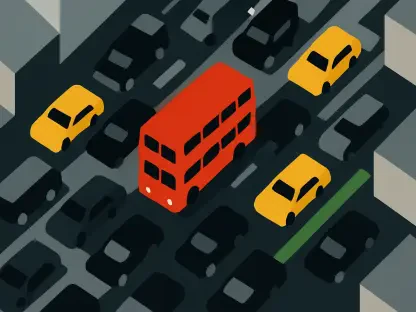In today’s fast-paced world, the burgeoning food delivery industry has seen a remarkable surge in popularity, driven by convenience and the increasing demand for quick meal solutions. However, this explosive growth comes with substantial environmental consequences, prompting a critical question: Can food delivery services become more sustainable and efficient? As consumers make more eco-conscious choices, food delivery businesses need to adapt and innovate to meet these new demands. The strategies and innovations discussed in this article shed light on various methods that can be employed to achieve a more eco-friendly and efficient food delivery process, offering solutions that simultaneously benefit the environment and enhance operational performance.
Optimizing Route Planning to Lower Emissions
One of the most effective ways to reduce emissions in food delivery is through optimized route planning. By leveraging advanced fuel and e-commerce order management systems, delivery routes can be streamlined. This minimizes unnecessary detours and idling, which are major contributors to high emission levels. For instance, an UberEats driver who uses an optimized route can significantly cut down on fuel consumption and emissions. Food delivery automation platforms play a crucial role in ensuring route optimization. These platforms help in minimizing excessive travel time and making better use of fossil fuels, whether it’s unleaded gas in a moped or diesel in a larger vehicle like an 18-wheeler. By adopting these technologies, food delivery businesses can not only reduce their carbon footprint but also improve operational efficiency.
Moreover, real-time data analytics can further enhance route planning. By continuously analyzing traffic patterns and delivery times, businesses can make informed decisions that lead to more efficient routes. This not only benefits the environment but also ensures faster delivery times, enhancing customer satisfaction. By incorporating dynamic route optimization systems, food delivery companies can adjust their routes based on real-time traffic data, weather conditions, and delivery urgency. This proactive approach not only reduces fuel consumption and emissions but also improves the predictability of delivery times. Implementing such systems requires investment in technology, but the long-term benefits in terms of sustainability and customer satisfaction can be substantial.
Embracing Eco-Friendly Packaging Solutions
Sustainability in food delivery extends beyond just fuel and vehicle movement; it also encompasses the packaging materials used. Traditional packaging, often contaminated with oils and other foodstuffs, poses significant challenges for recycling plants. Therefore, shifting to biodegradable materials, such as those made from bamboo or recycled paper, can greatly reduce waste. Statistics show that over 63 percent of municipal solid waste in the U.S. results from food packaging. By aligning inventory management with environmentally friendly packaging solutions, food delivery businesses can play a critical role in reducing this waste. This not only helps in mitigating landfill clogging but also appeals to eco-conscious consumers.
Additionally, businesses can explore innovative packaging designs that use less material without compromising on quality. For example, using compact and efficient packaging can reduce the overall volume of waste generated. This approach benefits the environment and reduces packaging costs, making it a win-win situation for businesses. Introducing reusable packaging options, such as containers that customers can return for a discount on their next order, can also make a significant impact. These solutions, although initially requiring some logistical adjustments, can engender consumer loyalty and contribute to a substantial reduction in single-use packaging waste. The transition to eco-friendly packaging is not only a responsibility but an opportunity to position a brand as a leader in sustainability.
Implementing Electric and Hybrid Vehicles
The adoption of electric and hybrid vehicles is another impactful strategy for reducing carbon dioxide emissions in food delivery. Programs like Uber’s Zero Emissions Incentive, which offers extra earnings to drivers of qualifying electric and hybrid vehicles, highlight the potential of EVs in this sector. Investing in electric vehicles offers numerous benefits, including reduced pollution and access to government incentives. These incentives can make the transition to electric vehicles more financially viable for businesses. Moreover, the reduced operational costs associated with electric vehicles, such as lower fuel and maintenance expenses, can further enhance the sustainability of e-commerce deliveries.
Furthermore, the use of electric bikes and scooters for short-distance deliveries can be a game-changer. These vehicles are not only eco-friendly but also highly efficient in navigating through congested urban areas. By incorporating a mix of electric and hybrid vehicles, food delivery businesses can significantly reduce their environmental impact. Pilot programs and partnerships with vehicle manufacturers can help determine the best mix of vehicle types for different delivery needs. Adopting EVs requires an initial investment in charging infrastructure and vehicle acquisition, yet the long-term savings and environmental benefits are profound. As technology advances, the efficiency and affordability of electric and hybrid vehicles will likely improve, making this a sustainable strategy for the future of food delivery.
Reducing Food Waste Through Better Inventory Management
Food waste is a major issue, with about one-fifth of food produced for human consumption being lost or wasted. This is particularly concerning given the global food insecurity and starvation issues. Real-time monitoring of food inventory through e-commerce order management systems can help address this problem. These systems enable better tracking of stock levels and more efficient use of ingredients. By aligning production with demand more accurately, businesses can reduce the environmental impact of food waste. This not only helps in conserving resources but also improves the overall efficiency of the supply chain.
Moreover, businesses can implement strategies to repurpose surplus food. For example, unsold food items can be donated to local food banks or used to create new menu items. By adopting such practices, food delivery businesses can contribute to reducing food waste while also supporting community welfare. Collaborating with local farms and suppliers to recycle food waste into compost or animal feed can also make a significant impact. These practices not only enhance a company’s sustainable image but also build stronger community connections. Better inventory management, supported by advanced data analytics, can predict demand more accurately, thus minimizing surplus food production and contributing to a more sustainable food delivery ecosystem.
Optimizing Delivery Frequency for Greater Efficiency
While optimizing delivery routes is beneficial, reducing the number of trips altogether can yield even greater sustainability gains. For instance, a hotel with 300 guests and multiple individual food delivery requests can consolidate these deliveries to cut down on idling, gas usage, and emissions. E-commerce order management systems can facilitate this by enabling the efficient combination of multiple orders into fewer trips. This not only enhances sustainability but also improves operational cost-efficiency. By reducing the frequency of deliveries, businesses can lower their carbon footprint and streamline their operations.
Additionally, businesses can explore subscription-based models that allow for scheduled deliveries. This approach can help in planning and consolidating deliveries more effectively, further reducing the environmental impact. By optimizing delivery frequency, food delivery services can achieve a balance between sustainability and customer satisfaction. Implementing bulk delivery days or offering incentives for scheduled deliveries can encourage customers to participate in more efficient delivery cycles. This not only benefits the environment but also reduces workload and operational complexity. The key is to find innovative ways to communicate these benefits to customers, ensuring they understand the positive environmental impact of consolidated delivery schedules.
Encouraging Customer Participation in Sustainability Efforts
In today’s fast-paced world, the burgeoning food delivery industry has seen a remarkable surge in popularity, driven by convenience and the increasing demand for quick meal solutions. However, this explosive growth comes with substantial environmental consequences, prompting the critical question: Can food delivery services become more sustainable and efficient? As consumers make more eco-conscious choices, food delivery businesses need to adapt and innovate to meet these new demands. The strategies and innovations discussed in this article shed light on various methods that can be employed to achieve a more eco-friendly and efficient food delivery process, offering solutions that simultaneously benefit the environment and enhance operational performance. This transformation includes adopting eco-friendly packaging, optimizing delivery routes, utilizing electric vehicles, and encouraging sustainable practices among partners. By doing so, food delivery services can significantly reduce their carbon footprint while enhancing customer satisfaction and operational efficiency. This balance between sustainability and efficiency is essential for the future success of the industry.









